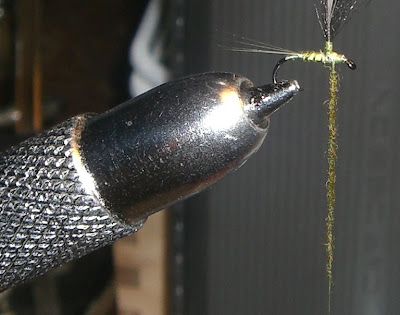
The thrill of findng new, small water keeps me pouring over the local OS maps in search of wild, brown trout throughout the year. There is so much to find, the maps littered with the burns, streams and rivers that traverse this largely rural landscape. Multiple access points exist where lanes cross the current and bridges span water. Many are now familiar, but hundreds of miles remain unchartered.
Finding new, small water in the hope of finding trout is the bread-and-butter business of the small stream fly fisher. That said, it's always welcome when you're lead by the nose to a previously unvisited pool, especially when it comes highly recommended by a discerning fisher with a lifetime of stream knowledge.
So I got speaking with Daniel yesterday, during the kids sports day. Daniel is an expert salmon fisher, and regularly hops across the border in to Co. Donegal to chase large, sea-run salmon. His best fish last year was 14lb, taken on the fly, of course. He also shares my passion for wild trout on small streams and before we agreed to meet up for some fishing (Daniel assures me he knows exactly where we can take wild, brown trout of 2 - 4lb on small dry flies... more to follow), he tipped me off on a local stream, close to home. The stream is a couple of miles from the front door, most of these streams are. It lies on land owned by a local farmer, whom I was assured would be more than happy to oblige with access. And so I set-off at 07:30 this morning to see if the reports of free rising trout were good. On arrival, I introduced myself to the farmer's son and asked permission to fish, which was willingly granted. Over the years, I have found permission is rarely denied if you take the time to ask, and I always repay the favour with a half dozen fresh eggs from home. It's not like the local farmers don't have more than enough of their own eggs, but the gesture is always warmly received. Our hens are worth their weight in gold for this alone.
There were three obvious pools, the first two holdng the smallest of dinks but they made a good start and helped establish a relaxed casting rythym as I settled in to the fishing. The top pool, almost directly opposite the farmhouse was where Daniel advised I fish. It became obvious why as I stood at the bottom of the pool.

The rises came in waves, every 30-40 seconds, as the surface was dimpled with maybe six to eight fish sipping tiny gnats at the surface. These were not large fish, maybe 4-6" but it was wonderful to the see such prolific surface activity as I started to pick off dinks, one at a time as I progressed up the pool. Take a look at the overhanging bush on the right side of the picture above. The activity here appeared more confident and the splashy rises were clearly from larger fish. The water was deeper, and it was possible to side cast low, above the feeding lane and again pick off trout, these were to 9" and very welcome.

A few were lost on the strike, but still they fed confidently. After half a dozen fish, a wayward cast left my fly (a #20 reverse parachute BWO emerger) snagged and irretrievable, so I called time on a wonderful hour or so of fishing.

It was another magical trip. Short but perfect. The thrill of fishing new water, and catching is hard to describe, but it elevates the spirit, and pretty much sets you up for the day.
So thanks go to Daniel, your tip was good. As for tracking down some larger trout, I hope it's this nice and easy...





































